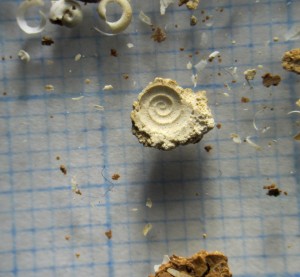Tufa imprints of shells
Some time ago I posted some photos of clay imprints of the inside of shells. This week I came across the imprint of the outside of a shell (I think this is also Discus rotundatus – but I’m open to being told otherwise) preserved in tufa:
Tufa is especially fascinating for me. It is a calcareous precipitate, in this case formed when spring water which has passed through limestone emerges and evaporates. In prehistoric Britain it seems to have formed in swampy woodland under the more humid climatic conditions that were present in the Mesolithic. It would often form extensive deposits across the landscape, many of which were several metres thick. These would have been visually striking, as the tufa would coat everything it came into contact with white, effectively petrifying plants. At Cherhill in Wiltshire, John Evans found tufa imprints of plant leaves in his snail samples (Evans & Smith 1983). It does still form in Britain, but on nothing like the same scale as in prehistory.
Here is a juvenile shell of Pomatias elegans covered in tufa:
Reference:
Evans, J.G., and Smith, I.F., 1983. Excavations at Cherhill, north Wiltshire, 1967. Proceedings of the Prehistoric Society, 49, pp. 43-117.


Trackbacks